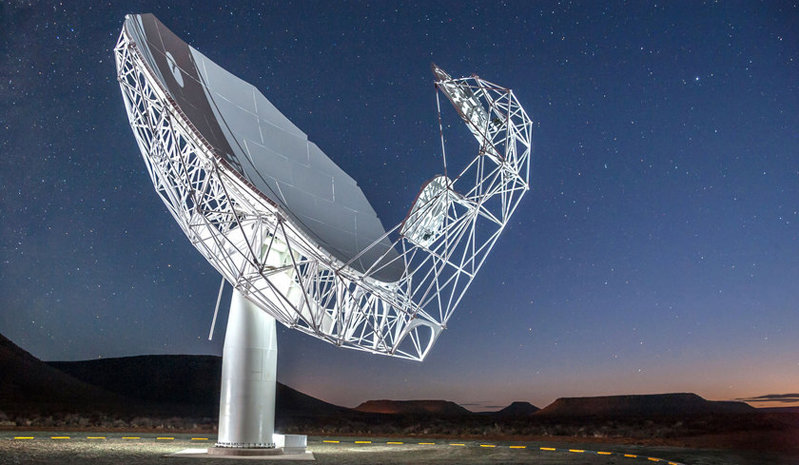A new window into the radio sky
MeerKAT in South Africa is a ground-breaking telescope and promises exciting insights into processes taking place in outer space
It is the largest and most sensitive radio telescope in the southern hemisphere: 64 dish-shaped individual antennas – each with a diameter of 13.5 m – listen into space from South Africa and allow researchers to investigate distant radiation outbursts as precisely as pulsars or interstellar clouds within our own Milky Way. An important receiver system for this giant “ear” called MeerKAT comes from the Max Planck Institute for Radio Astronomy in Bonn. The Max Planck Society is providing an additional € 20 million for the construction of 20 additional antennas. According to Max Planck President Martin Stratmann, the MeerKAT project is “a milestone in radio astronomy”.

The premises of MeerKAT, which lie about 90 km outside the South African city of Carnavon on the North Cape has become the Mecca of radio astronomers. Thanks to its unique location in the Karoo semi-desert region, the system is only slightly affected by terrestrial interference radiation. This means that its sensitivity can be fully utilised.
In addition to visible light, radio astronomy opens another window to the universe. However, the quality of the observations depends on the sensitivity of the telescopes. Factors such as the accessibility of the celestial regions, time and frequency resolution, and the speed of mapping the firmament also play an important role.
MeerKAT currently comprises 64 individual antennas. After the upgrade, it will be expanded to a total of 84 antennas, each with a diameter of 13.5 m. The dishes can be interferometrically combined into a single telescope and operate in a so called offset Gregory configuration. This allows increased sensitivity (because of the full opening of the mirror), excellent image quality, and good shielding against unwanted interference from satellites or terrestrial transmitters.
The system is more sensitive than the largest mobile single telescopes in our northern hemisphere, the 100-metre antennas in Effelsberg near Bonn and in Green Bank in West Virginia. The 20 additional antennas will drastically increase the performance of the system. The spatial resolution of the 84 interconnected dishes of MeerKAT will thus correspond to that of a radio telescope 17 km in diameter.

In November 2015, the basic cooperation agreement for MeerKAT was concluded between the Max Planck Society and the South African partners. Among others, the South African Minister for Science and Technology, Naledi Pandor, and the President of the Max Planck Society, Martin Stratmann were present at the ceremony in Berlin.
On the part of the Max Planck Society, the cooperation mainly involves scientists from the Max Planck Institute for Radio Astronomy who collaborate with colleagues from the Universities of Manchester and Oxford on data processing. The receiver system installed in the meantime consists of a front-end system for data acquisition and a back-end system for data processing with high time resolution. The frequencies are between 1.6 and 3.5 GHz. The recorded data rate of 5.5 TeraBit (1 TeraBit = 1012 Bit) corresponds to 147 completely filled DVDs per second.
“The MeerKAT receiver project at our institute will provide a system excellently suited to the interests of our scientists”, says Gundolf Wieching, head of the Electronics division at the Max Planck Institute for Radio Astronomy at the signing of the cooperation agreement in Berlin. “This will allow us to use the full potential of the receiver”.
When asked about the possibilities of MeerKAT, Max Planck Director Michael Kramer said: “We expect progress in the field of fundamental physics with tests of theories of gravitation and the detection of gravitational waves via pulsar observations”. According to Kramer, the observations include the study of dynamic changes in the radio sky (e.g. short-lived radio bursts at cosmological distances), sensitive molecular spectroscopy of the interstellar medium, and high-resolution images of radio sources.
With MeerKAT, the future of radio astronomical observation has begun. The system will be integrated into the Square Kilometre Array (SKA). The SKA project will be built at sites in South Africa and Australia and will include thousands of antennas of different types with a total catchment area of one million square meters. The antennas will also be separated by up to 3000 km. Interconnected by the technique of interferometry, this results in an enormously high resolution of detail – the SKA will thus exceed that of the Hubble Space Telescope by a factor of 50. And another record: the SKA should be able to scan the sky about ten thousand times faster than is currently possible.
HOR
This article first appeared on 11 November 2015 and was updated on 17 September 2020.













